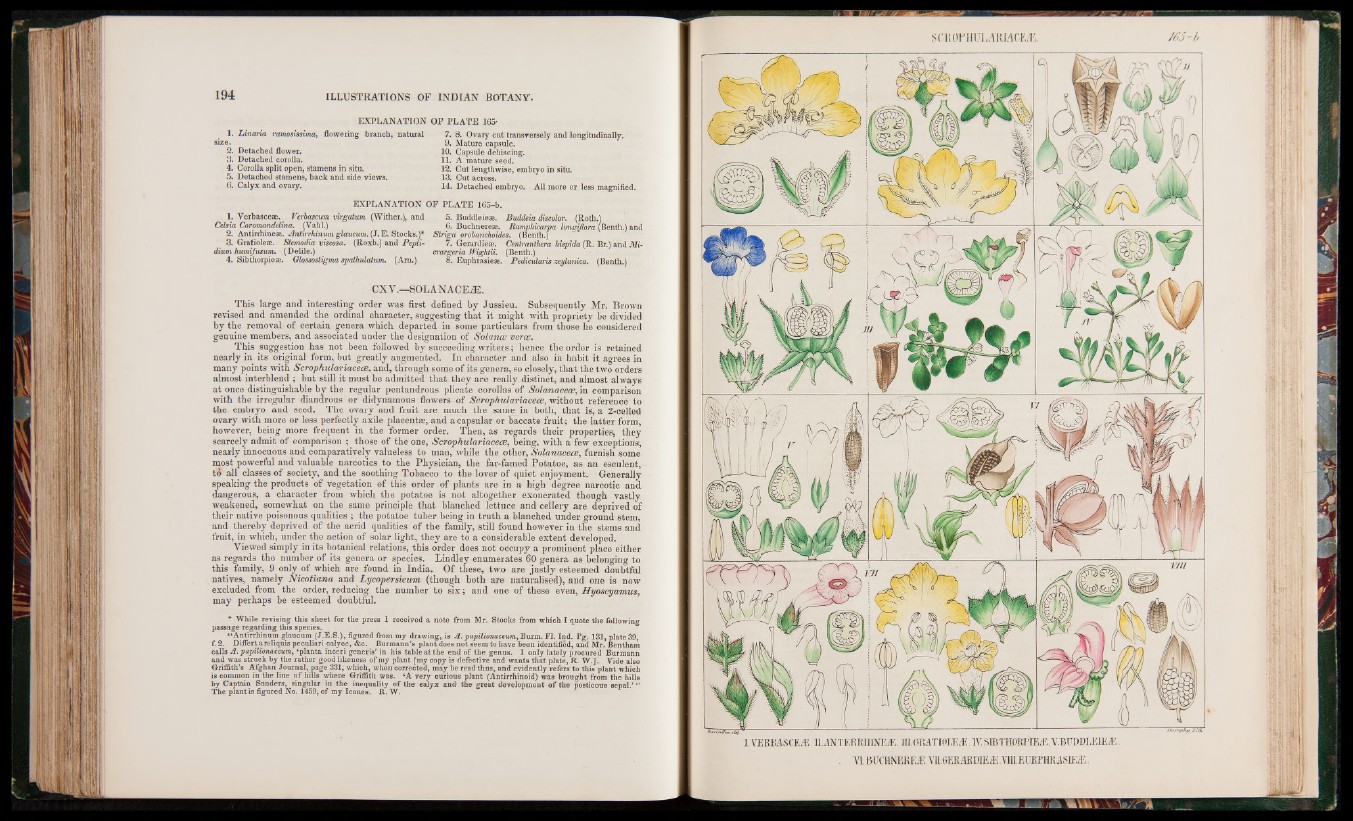
EXPLANATION
1. Linaria ramosissima, flowering branch, natural
size.2
. Detached flower.
3. Detached corolla.
4. Corolla split open, stamens in situ.
5. Detached stamens, back and side views.
6. Calyx and ovary.
EXPLANATION
1. Verbasceae. Verbascum virgatum (Wither.), and
Celsia Coromandelina. (Vahl.)
2. Antirrhineae. Antirrhinum glaucum. (J. E. Stocks.)*
3. G rat ideas. Stemodia viscosa. (Roxb.) and Pepli-
dium humifusum. (Delile.)
4. Sibthorpieae. Glossostigma spatkulaium. (Am.)
OF PLATE 165-
7. 8. Ovary cut transversely and longitudinally.
9. Mature capsule.
10. Capsule dehiscing.
11. A mature seed.
12. Cut lengthwise, embryo in situ.
13. Cut across.
14. Detached embryo. All more or less magnified.
OF PLATE 165-b.
5. Buddleieae. Buddeia discolor. (Roth.)
6. Buchnereaj. Ramphicarpa longijlora (Benth.) and
Striga orobanchoides. (Benth.)
7. Gerardieae. Centranthera hispida (R. Br.) and Mi-
crargeria Wightii. (Benth.)
8. Euphrasieae. Pedicidaris zeylanica. (Benth.)
CXV.—SOLANACEiE.
This large and interesting order was first defined by Jussieu. Subsequently Mr. Brown
revised and amended the ordinal character, suggesting that it might with propriety be divided
by the removal, of certain genera which departed in some particulars from those he considered
genuine members, and associated under the designation of Solance verce.
This suggestion has not been followed by succeeding writers; hence the order is retained
nearly in its original form, but greatly augmented. In character and also in habit it agrees in
many points with Scrophulariacece«and, through some of its genera, so closely, that the two orders
almost interblend ; but still it must be admitted that they are really distinct, and almost always
at once distinguishable by the regular pentandrous plicate corollas of Solanaeece, in comparison
with the irregular diandrous or didynamous flowers of Scrophulariacece., without reference to
the embryo and seed. The ovary and fruit are much the same in both, that is, a 2-celled
ovary with more or less perfectly axile placentae, and a capsular or baccate fruit; the latter form,
however, being more frequent in the former order. Then, as regards their properties, they
scarcely admit of comparison ; those of the one, Scrophulariacece, being, with a few exceptions,
nearly innocuous and comparatively valueless to man, while the other, Solanaeece, furnish some
most powerful and valuable narcotics to the Physician, the far-famed Potatoe, as an esculent,
to all classes of society, and the soothing Tobacco to the lover of quiet enjoyment. Generally
speaking the products of vegetation of this order of plants are in a high degree narcotic and
dangerous, a character from which the potatoe is not altogether exonerated though vastly
weakened, somewhat on the same principle that blanched lettuce and cellery are deprived of
their native poisonous qualities ; the potatoe tuber being in truth a blanched under ground stem,
and thereby deprived of the acrid qualities of the family, still found however in the stems and
fruit, in which, under the action of solar light, they are to a considerable extent developed.
Viewed simply in its botanical relations, this order does not occupy a prominent place either
as regards the number of its genera or species. Lindley enumerates 60 genera as belonging to
this family, 9 only of which are found in India. Of these, two are justly esteemed doubtful
natives, namely Nieotiana and Lycopersicum (though both are naturalised), and one is now
excluded from the order, reducing the number to six; and one of these even, Hyoscyamus,
may perhaps be esteemed doubtful.
* While revising this sheet for the press 1 received a note from Mr. Stocks from which I quote the following
passage regarding this species.
“ Antirrhinum glaucum (J.E.S.), figured from my drawing, is A. papilionaceum, Burm. FI. Ind. Pg. 131, plate 39,
f. 2. Difiert areliquis peculiari calyce, &c. Burmann’s plant does not seem to have been identified, and Mr. Bentham
calls A. papilionaceum, ‘planta i'nceri generisr in his table at the end of the genus. 1 only lately procured Burmann
and was struck by the rather good likeness of my plant [my copy is defective and wants that plate, R. W.]. Vide also
Griffith’s Afghan Journal, page 331, which, when corrected, may be read thus,, and evidently refers to this plant which
is common in the line of hills where Griffith was. ‘■A very etrrious plant (Antirrhinoid) was brought from the hills
by Captain Sanders, singular in the inequality of the calyx and the great development o f the posticous sepal.’ ”
The plant is figured No. 1459, of my leones. R. W.
S CK OF HUL AUIACEÆ 165-b
i .yekbasceæ.ii.æntertihineæ.iu.gratioi.eæ:.iv.sibthorfïeæ.y.buddleieæ;
. 'VLBUCHNERFÆ.VÜ.&ERARDIEÆ.mEIJRFHRASIEÆ;.